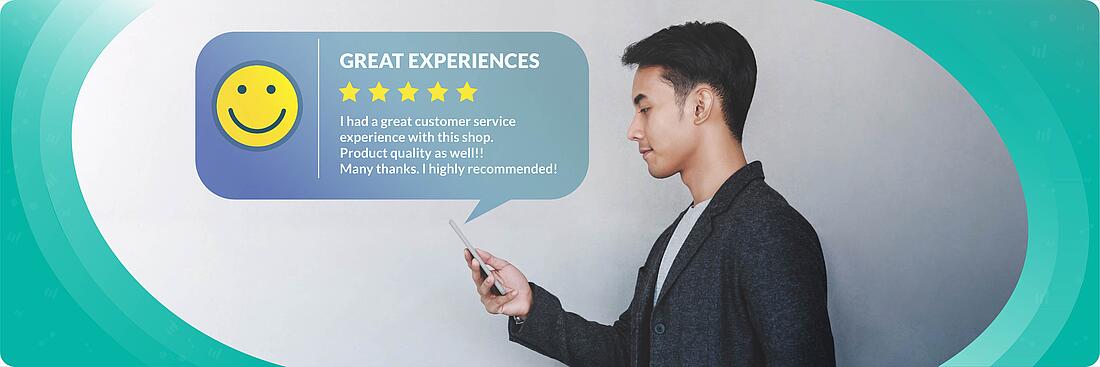- Why Us?
- Features
White Label
For SaaS Platforms & Agencies
Provide our complete analytics suite to your clients, directly within your own interface and with your/their own branding. Discover Analytics-as-a-Service and White Label Analytics. Great benefit, minimal effort.
- Pricing
- White Label
- Success Stories
- Resources

Simon Coulthard February 28, 2025
5 min
CONTENTS
- What is Customer Experience (CX)?
- Customer Experience vs. Customer Service: Know the Difference
- How Important is Customer Experience?
- Why Customer Experience Is Key to Scaling Revenue Growth
- How is Digital Transformation Driving Customer Experience?
- What Are the Three Main Components of Customer Experience?
- What is Customer Experience Management?
- What are the Benefits of a Good Customer Experience?
- 10 Things that Cause a Bad Customer Experience
- How do you Build a Good Customer Experience?
- 1. Establish a Customer-Focused Vision
- 2. Know Exactly Who Your Customers Are
- 3. Prioritize Customer Feedback
- 4. Build an Emotional Bond with Your Customers
- 5. Measure the ROI
- How to Measure and Analyze Customer Experience
- 1. Pinpoint the best customers that you want to focus on
- 2. Decide which journey touchpoints you want to focus on
- 3. Collect the customer feedback and insights you need
- 4. Analyze your collected data
- Why you Should Use Customer Feedback as Part of Your CX Strategy
- What are Customer Experience Skills?
- 1. Data-Driven Approach
- 2. Strategic Mindset
- 3. Inter-Department Collaboration
- 4. Project Simplification
- 5. Empathy Towards Customers
- 6. Proficient Communication
- 7. Adaptability
- What Are the Latest Trends in Customer Experience in 2025?
- Hyper-personalization
- Cohesive omnichannel experience
- Data security & privacy
- Integration of customer-facing functions
- How Is Customer Experience at TWIPLA?
What is CX? - Customer Experience in Marketing & Why it’s Important

Customer experience (CX) refers to the interaction between customers and businesses at every point in their journey, and includes marketing, support, and everything in between.
What’s more, it involves the all-important emotional element - in that CX not only relates to the initial interactions a customer has with a company, but how it makes them feel afterwards too.
CX is a vital part of modern business, and this article runs through everything you need to know. Feel free to scroll through the article at your leisure or alternatively click on nay of the questions below to jump to the answer you’re looking for.
What is Customer Experience (CX)?
Customer experience - otherwise known as CX - is the perception that customers have of a company.
They’ll form this based on how they feel throughout the various interactions they have with you - from the initial advertisement they see to post-sales support, and all the various marketing touch points in between.

Customer Experience vs. Customer Service: Know the Difference
Customer service is the direct one-to-one support provided by either an in-house customer support representatives or sometimes outsourced to answering service provider that offers support to your customers before, during, and after they purchase a product or service, and represents one small part of the full customer journey.
By contrast, customer experience encompasses all the interactions that they have with your brand.
How Important is Customer Experience?
CX is important because it ultimately determines the success of any company - the better it is, the easier it is for people to do business with you.
Improve your customer experience, and your company will experience more customer loyalty, more repeat business, and more brand advocacy from them.
Just look at the figures - 76% of people will move to a competitor if they have just one bad experience (Acquia), while 87% of business leaders see CX as their priority for growth (North Highland).
Why Customer Experience Is Key to Scaling Revenue Growth
By improving the customer experience, your company will benefit from higher customer loyalty, better retention rates, and increased revenue.
This is reflected in the statistics; 83% of companies that place value in making customers happy experience growing revenue (Hubspot), while businesses with better CX bring in nearly six times more revenue than competitors (Forbes).
How is Digital Transformation Driving Customer Experience?
Digital transformation refers to the incorporation of the internet and its related technologies into everything a business does.
Simply put, the internet is central to modern life and this forces all companies to adapt their business models accordingly.
Customer experience is an essential part of this process and is actually driving digital transformation - rather than the other way around.
This is because the nature of the digital world actually puts the customer firmly in control, and it’s up to companies to keep up with their expectations if they’re to remain competitive.
Ultimately, they expect an excellent CX or they’ll look somewhere else.
Just look at the internet today and you’ll understand that people expect relevant content in relation to whatever they’re doing online, on whatever device or platform they’re using. They expect data security, immediate replies from customer support, next-day doorstep delivery - the list is endless.
Furthermore, digital transformation enables companies to better understand what customers want and this helps them meet their expectations. When done right, success online drives down operating costs and gives companies a distinct competitive edge.
What Are the Three Main Components of Customer Experience?
While CX can be divided any number of ways, it is generally broken down into three main components:
- Success - is the customer able to get what they want from each specific interaction they have with you?
- Ease - how much effort did the customer have to invest into each specific interaction?
- Positivity - how did the customer feel emotionally after each specific interaction?
What is Customer Experience Management?
Customer experience management, often referred to as CXM or CEM, is a marketing strategy that prioritizes customer engagement, satisfaction, and experience.
Ultimately, this comes down to surveying, analyzing, and enhancing customer interactions with your business.
What are the Benefits of a Good Customer Experience?
Beyond the all-important revenue generation, there are four key benefits to providing a good CX:
- Your customers will advocate on your behalf and you’ll have more new customers as a result
- Increased customer satisfaction means that you’ll get more repeat business
- You’ll understand your customers better, which will increase efficiency, and drive down costs
- Your customers will trust you more, enhancing your brand reputation and mitigating any damage done in the face of negative attention
10 Things that Cause a Bad Customer Experience
CX encompasses the full customer journey, from marketing to post-sales care. This means that there’s no shortage of issues that can reduce the customer experience, but you can find the 10 key issues below:
- A website that is poorly designed, slow, or frustrating to navigate
- Poor personalization that means customers are not being given the content they need
- An inability for customers to pick up where they left off at the end of their last session
- Poor cross-device compatibility or a poor omnichannel strategy
- A clunky sign-up process, or unexpected demands for credit card information
- Poorly-conceived pricing levels
- Products/services that do not meet customer expectations
- Substandard tutorials that stop customers getting the most out of their purchase
- Unresponsive, uninformed, or unfriendly customer support
- Inadequate data privacy and/or security that puts customer data at risk
How do you Build a Good Customer Experience?
Good CX can be achieved by following this 5-step roadmap:
1. Establish a Customer-Focused Vision
You need to be able to explain to your company what vision you have for its CX - something that is best achieved by creating a series of guiding principles.
This could be anything from resolving complaints as quickly as possible to having positive can-do customer support.
Once these principles have been decided, you can then use them to underpin every policy and process across your organization, so that everything you do revolves around making your customers happy.
2. Know Exactly Who Your Customers Are
In order to offer the best CX possible, you need to know who your customers are and what they want - so that your customer support team can meet their expectations.
Practically speaking, a good way of doing this is to segment your customer base according to their age and product knowledge, and to then use these customer profiles to help your customer support team.
3. Prioritize Customer Feedback
You may think you have CX nailed, but you can’t be sure without customer feedback or visitor communication. .
As such, it's vital that you use things like surveys and polls to get real-time advice from them about what you’re doing well and what you could improve.
Crucially, it’s important that you act on this information, pass it to everyone at your company, and use it to guide your CX optimization work.
4. Build an Emotional Bond with Your Customers
Simply put, customers will remember positive interactions they have with a business because these are all too rare today. Taken further, they’ll happily advocate for your company if they feel like you have gone above and beyond to help them.
Take Tesla, who literally send mechanics to their clients houses to fix their vehicle at the time of their choosing. Or Nordstrom, who have a policy of doing what customers want every time - even if it means refunding them for a tire the customer bought somewhere else.
Such policies make these companies stand out from the crowd and enable them to build a strong emotional connection with customers - there’s a reason why Tesla cars are so sought after, despite Elon Musk not being everyone’s cup of tea.
5. Measure the ROI
You may be following this advice to the letter, but how do you know if you’ve actually built a good CX?
Simply put, customer experience can be assessed by using a Net Promoter Score (NPS) - a valuable KPI that asks one single straightforward question: “How likely are you to recommend us?” The higher the score, the more successful the customer experience optimization.
How to Measure and Analyze Customer Experience
In order to effectively analyze the customer experience you provide, you’ll want to complete the following 4-step process
1. Pinpoint the best customers that you want to focus on
The best customers are those that, if they experience an amazing CX, are most likely to return to you again and again.
You can find out who they are by using surveys and other customer contact tools to assess who your website visitors are, what they do, and what they would use your products for.
You can then improve this list further by focusing on the most active internet users - or those that have been active most recently - and then use this information to create the user personas that you will need for the two steps that follow.
2. Decide which journey touchpoints you want to focus on
Once you’ve created your user personas, you’ll then want to decide what exactly you want to focus on in terms of your CX optimization work.
To this end, you could focus on users that are appropriate to touchpoints that warrant special attention, such as those that:
- Have just visited your website for the first time
- Recently purchased a product from you
- Failed to onboard after sign-up, or asked for a refund after purchase
- Frequently contacted customer support
- Regularly referred friends to your company
3. Collect the customer feedback and insights you need
Now that you have segmented your customer base in a way that will make your analysis useful, you’ll want to collect the customer feedback you need and this can be done in a number of ways:
- Website data analysis
- Surveys and/or polls
- Unscripted interviews
- Track user sentiment
4. Analyze your collected data
Once you’ve completed these steps and have collected the data you want, you’ll then want to analyze it effectively - both in terms of individual customer issues, and any broader issues with your company’s policies, processes, products, and so forth.
You can analyze this data by using any of the following CX metrics:
- Net Promoter Score (NPS) - this takes the form of a single survey question, and asks customers to rate how likely they are to recommend your company to people around them
- Customer Effort Score (CES) - this measures how easy it is for a customer to do business with you, and is done through a CES survey
- Customer Satisfaction (CSAT) - this tracks how satisfied customers are with your company’s products and/or services
- Response time - this is the amount of time it takes for a customer to get a response from your support team
- Sentiment - this uses machine learning to analyze social media posts to determine how people feel about your company

Why you Should Use Customer Feedback as Part of Your CX Strategy
You no doubt understand what distinguishes a good customer experience from a bad one, but implementing an effective strategy requires that you have reliable access to what improvements your customers actually want.
This is where customer feedback, or visitor communication, comes in.
Beyond getting the information you need, it shows that you value their opinion, they feel more attached to your company, and they’ll be more likely to forgive any mistakes, buy from you again, and advocate on your company’s behalf.
What are Customer Experience Skills?
If you want to become a customer experience professional, then you’ll need to develop the following 7 skills if you’re to become successful:
1. Data-Driven Approach
CX professionals need to know exactly what’s working and what isn’t, but you can’t make effective improvements unless you can accurately measure whether customers are getting what they want.
This is why data analysis is so important, and why website statistics, visitor behavior analysis, and feedback/communication tools should be central to everything you do.
2. Strategic Mindset
Great customer experience can only be achieved if it is integral to the wider objectives of your company.
As such, all work should take into consideration both the current effectiveness of the company in a given CX area and the goal that you’re working towards.
Priorities do change as companies develop, and could be anything from building a customer base to focusing on customer retention, but it’s important to know where your company sits in this process and develop a CX strategy accordingly.
3. Inter-Department Collaboration
Since customer experience includes everything from marketing to after-sales care, it’s vital that your strategy pulls together all the different departments at your company - to ensure that everyone is working together towards a common goal, and that no work is siloed.
For CX professionals, this means that the ability to build in-house relationships should be an important skill to have in your pocket.
4. Project Simplification
It is certainly true that the ability to effectively take ownership and manage a project from planning to completion will distinguish CX professionals from others in their field.
Success here ultimately depends on your ability to take an end goal, break it down into manageable tasks, and allocate work to the others at your company who are most capable of completing it. You can utilize documents like project proposal to outline objectives, track progress, and ensure alignment with end goals within the specified timeline.
5. Empathy Towards Customers
The work of CX professionals largely revolves around responding to customer issues and complaints.
It’s certainly good to try to resolve these as quickly as possible, but it’s important to approach this work with empathy - since this will build loyalty and drive your business forward.
No two customers are the same; you’ll face the full spectrum of human emotions, and it’s important that you build the skills to respond to them in a way that makes them feel heard and valued.
6. Proficient Communication
Identifying problems and building responsive strategies are certainly important, but these skills won’t count for much if you’re unable to explain what you want effectively to those working next to you.
And, given just how customer-centric this work is, you get an idea of how important developed communication skills are to the success of CX professionals.
7. Adaptability
Make no mistake, customer experience is an industry of constant flux, and CX professionals have to keep pace with both technological advancements and fast-changing customer expectations. To be successful, CX professionals need to keep up-to-date with these changes, and to be able to switch quickly to new channels, initiatives, emerging technologies and so forth.

What Are the Latest Trends in Customer Experience in 2025?
The digital world is an ever-changing landscape, but the four key trends in customer experience that have real staying power are:
Hyper-personalization
Given the many potential benefits, more and more companies are prioritizing CX, and we’re now seeing a widespread trend towards hyper-personalized customer journeys.
Hyper-personalization refers to the most highly developed way that companies can tailor their outreach to individual customers, and the importance of this for businesses will only grow as we move forward.
Cohesive omnichannel experience
Omnichannel marketing refers to the provision of a seamless customer journey across multiple channels and devices.
This is more important for business than ever before, and is seen by experts as the foundation of the strong customer relationships needed to succeed.
Data security & privacy
As the digital world grows ever more important for business success, consumer data privacy and security will increasingly dictate whether companies can attract and keep hold of customers.
In practice, what this means is prioritizing compliance with GDPR and other global data privacy laws, by constantly monitoring and updating whatever data privacy measures you have in place.
Integration of customer-facing functions
Customer-facing functions refer to any business activity that involves direct interaction with a client or customer.
Up until recently, customer support, chatbots, polls, and surveys - for instance - have remained largely siloed off from each other.
However, that is fast changing, with the increasing popularity of unified tech solutions enabling companies to make huge strides in their CX strategy.
How Is Customer Experience at TWIPLA?
First of all, it’s important to say that we are a privacy-first company - so, our customer data is always 100% safe and secure.
This is very much foundation number one of good customer experience, as it enables us to rapidly build trust.
Beyond that too, it should be noted that many of our customers are attracted to our product as a result of our independently audited privacy-perfect rating - and thus we are able to speak the same language from day one.
When it comes to customer support, though of course we use certain technologies to help optimize the efficiency of our service, we very much believe that it’s our people that make the biggest difference.
As a result - and this is true for all departments, but especially customer-facing roles - we place a huge amount of importance on hiring the right people, and then providing them with the resources and conducive environment to do a great job.
As part of monthly reporting, this great team of professionals has NPS (Net Promoter Score) as their North Star metric. By constantly striving to improve, this laser focus has resulted in a huge number of positive reviews and an ever-increasing amount of referral business.
We are currently developing a wider referral and reward programme, in order to further optimize the benefit we can draw from satisfied customers.
Beyond that, the customer support professionals are also working tirelessly to optimize response times and, in collaboration with other departments, ensure that any issues or requests are dealt with quickly and effectively.
As is the case with other departments too, our support team leverages our own Customer Communication tools to gain direct insights from our user base. And, over the years, such feedback has very much played a direct role in shaping our product and feature upgrades and roadmap.
We have a fierce focus on community - both internally and within our customer base - and thus prioritize building long-term relationships, rapport, and going the extra mile to make our customers feel appreciated.
Of course, as is the case with any company, we do sometimes receive negative feedback. The key thing in this respect is that we always openly share such information with the rest of the company. We have dedicated alignment meetings and shared docs, where we outline areas that have drawn criticism and strategize ways of quickly addressing such concerns.
At the heart of everything to - and it’s something that’s already been touched upon - we very much see customer experience as being integrated and aligned with every single step of the customer journey.
We are very much proactive in blurring the lines between various functions and look to build sturdy bridges between, for example, support, success, product, marketing, and sales. Not only does this optimize both our product and services, but it also ensures the consistency of our messaging and leaves less room for confusion.
Customer experience continues to be priority number one for us as a company and, as such, we are currently building out our Customer Success function, onboarding new technology, and evolving the automated elements of onboarding and in-product training to make the journey ever smoother - and more enjoyable.
You Made it to the End!
Since you’ve made it this far, you now have a much better understanding of just how important customer experience is for modern business - they’re a demanding bunch, but will reward good CX when they find it.
And if you’re looking to improve the customer experience at your company, have a look at our visitor feedback tools, as well as our GDPR and data privacy resource hub, and how to secure the personal information of your customers.
And if you liked what you read and think it might help other marketers, feel free to share it around!
Share article
Get Started for Free
Gain World-Class Insights & Offer Innovative Privacy & Security

You might also like
What is Virtual Reality Marketing? 01 July 2022 - by Simon Coulthard
01 July 2022 - by Simon Coulthard
How is Blockchain Used in Marketing? 01 July 2022 - by Simon Coulthard
01 July 2022 - by Simon Coulthard










